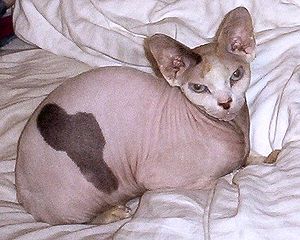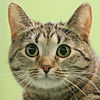Hairless cat
| Hairless cat | |
|---|---|
| Standard No. | |
| Shoulder height | |
| length | |
| Weight | Male: Ø kg female: Ø kg |
| allowed colors | all |
| colors not allowed | ./. |
| permitted coat drawing | Naked |
| not allowed coat drawing | haired |
| List of cat breeds | |
Naked cat is a collective name for the group of hairless domestic cats , whose defining breed characteristic is the almost missing fur.
Appearance
Hairless cats are not completely hairless in most cases. The body fur of the animals is so short that it is mostly only recognizable as a light hair fluff. The skin of a naked cat looks as if it only loosely covers the body. The skin of young animals tends to form wrinkles, which grow together with increasing age and then mostly only remain in the head area and on the joints.
The ears of the muscular cats in particular appear particularly large due to the almost lack of fur. The vibrissae in naked cats are often short or wavy and break off easily.
Hairless cats come in all colors that are not due to the special coloring of individual hairs, such as ticking .
Myths
Alleged reports of naked cats from ancient times have not yet been proven. The often claimed attitude of hairless cats among the Aztecs also comes from the imagination. But the hairless cat is very well known in the ancient Egyptian stories. There is even a statue of her known worldwide, the Sphinx.
origin
The earliest documented record of hairless cats is from 1878. A Boston Post newspaper article dated January 22, 1878, states that the hairless descendants of a blue Maltese cat in the Boston Music Hall from January 21-26, 1878 were issued.
The cat couple "Lady Nell" and "Dick" Shinick, of which the oldest known figure of naked cats from Mexico exists , achieved greater fame . The photo was first published in the Chicago Daily News on April 11, 1898 and has since been featured in several cat books. The animals came to be known as the Mexican hairless cat .
Up until the middle of the 20th century, hairless specimens were found in cat litters around the world, which initially mainly attracted scientific attention. The targeted breeding of naked cats began in North America in the 1960s . Breeding experiments with a hairless Siamese male resulted in hairless animals in 1966, which were known as mooncats . The foundation for the first of the bare cat breeds recognized today, the Canadian Sphynx , was finally laid through several, initially independent breeding attempts in Canada and later continued in the Netherlands .
In the 80s of the last century, a cat was finally found in what was then Russia, which had completely different genetic requirements for nudity. The breed of Don-Sphynx arose from the mating of the cat "Varvara" with various house cats from Rostov on Don .
Both the Canadian Sphynx and the Don Sphynx are mated with different visible traits , in order to obtain further naked cat breeds with different characteristics. Some of these properties are to be classified as questionable from the point of view of animal welfare .
Races
The oldest of the recognized hairless cat breeds bred to date is the Canadian Sphynx . The Don-Sphynx come from Russia and the Peterbald from further mating with the Oriental Shorthair . These two breeds are also recognized in many cat breeding associations.
A variant of the Sphynx cat, the Kohana cat, comes from Hawaii , whose skin has no or only small hair follicles and is therefore completely hairless. The Kohana is not recognized as an independent cat breed.
In addition, for some time now there have been cat breeds that are partially hairless and, especially in America, are offered by individuals as short-legged minskins or werewolf cats .
Genetic bases
Hairlessness in hairless cats is due to recessive inheritance, as in the Canadian Sphynx, which has a mutation in the KRT71 gene (keratin). The same mutation leads to another phenotype, that of the Devon Rex with its short, wavy coat. In this case there is a polymorphism of the gene (see also: Phenotypic variation # variations within a species and between different species ).
In the Don Sphynx breeds, however, a different gene (which is inherited dominantly ) is responsible for the hairlessness.
character
All bare cat breeds are described as particularly affectionate, intelligent, and playful. Already in a letter from one of the first documented naked cat owners from 1902 it says: "... they are the most intelligent and loving family animals that I have ever seen among cats, the fastest and the most intelligent cats I have ever seen."
Keeping and care
The hairlessness of hairless cats gives the impression that these cats have a higher body temperature than other cats. In fact, the body heat of hairless cats is only perceived as higher through direct contact with the cat's skin. Hairless cats need a high-quality diet because they have a slightly higher energy requirement, which is particularly needed to maintain their body temperature. Due to the lack of fur, light-skinned Sphynx cats are more sensitive to solar radiation. You can get sunburn from unprotected contact with the sun and must be specially protected from the sun. Due to the lack of fur, the excretions of sebum are distributed on the skin of naked cats. This can lead to greasy residues on the cats' beds. As a preventive measure, cats should be bathed occasionally or wiped with a damp cloth.
Legal situation
One commissioned by the Federal Ministry of Consumer Protection, Food and Agriculture created opinion on the interpretation of § 11b of the German Federal Animal Welfare Act (prohibition of torture breedings ) in 1999 came to the conclusion that it is in cats to torment farms when the animals whiskers missing .
In September 2015 the Berlin Administrative Court confirmed the order of the Veterinary and Food Inspection Office to a breeder to have her breeding male neutered and to stop breeding immediately. This is the first judgment on torture breeding since the amendments to the Animal Welfare Act came into force in July 2013. The court justified its decision by stating that the whiskers of a cat are an important sensory organ and the lack of them is therefore to be regarded as harm and suffering for the animal.
Similar animal welfare regulations apply in Austria and Switzerland. No judicial decisions on the keeping or breeding of naked cats are known from these countries.
literature
- Alexa Capra, Daniele Robotti (1999): Cats, getting to know-keeping-care-breeding . Klagenfurt: Neuer Kaiser Verlag, pp. 187-189, ISBN 3-7043-2189-3 .
Individual evidence
- ↑ Skupin, Marcus: Hairless Felids - Origin | Races | Keeping, ISBN 978-3-8482-2449-4
- ↑ Skupin: Hairless Feliden, p. 26.
- ↑ Skupin, Marcus: Sphynx - The naked truth, ISBN 978-3-7322-4535-2
- ↑ Skupin: Sphynx - The Naked Truth
- ↑ Sphynx , at geliebte-katze.de (accessed on August 1, 2013)
- ↑ Expert opinion on the interpretation of Section 11b of the Animal Welfare Act (prohibition of torture breeding). (PDF) (No longer available online.) Group of Experts, Animal Welfare and Pet Breeding, archived from the original on December 17, 2013 ; Retrieved December 17, 2013 . Info: The archive link was inserted automatically and has not yet been checked. Please check the original and archive link according to the instructions and then remove this notice. P. 54
- ↑ Naked cats without whiskers are torture breeding (No. 33/2015). In: berlin.de. September 23, 2015, accessed September 24, 2015 .


